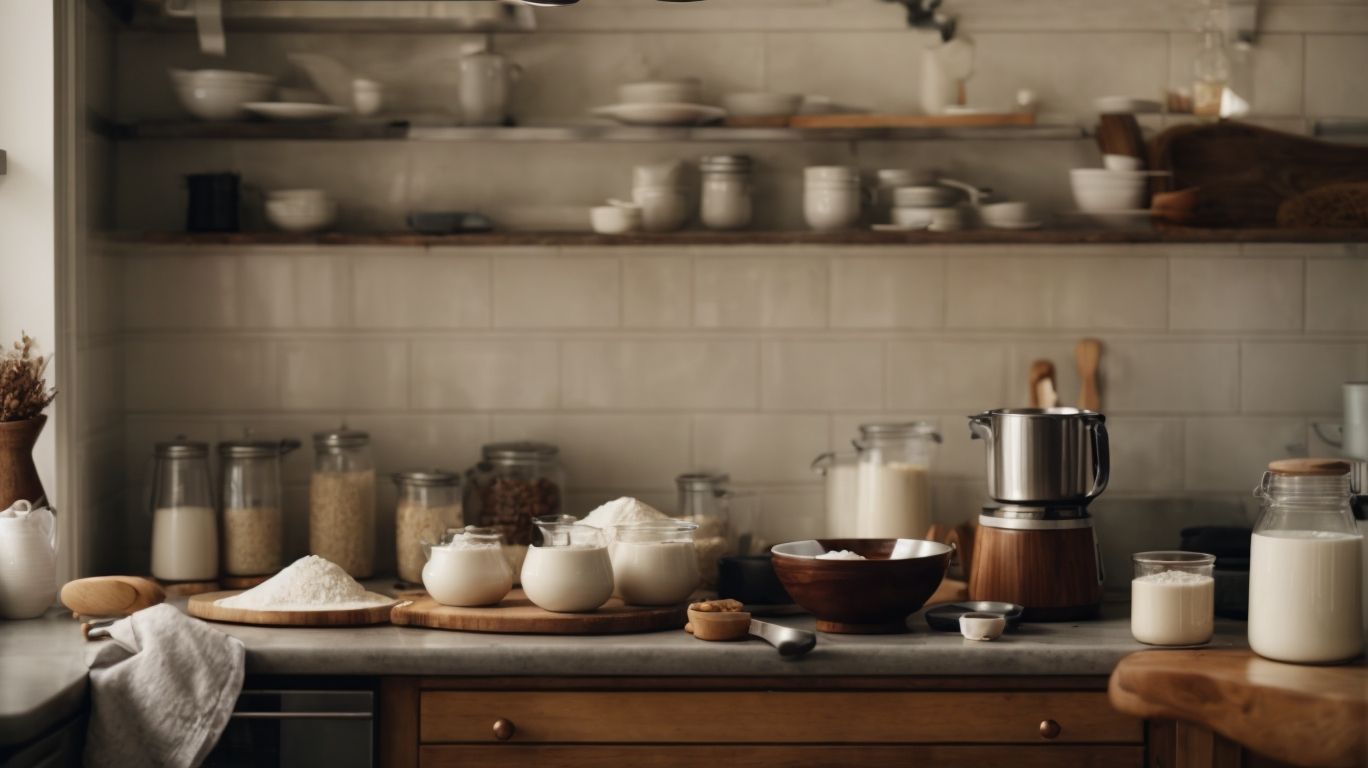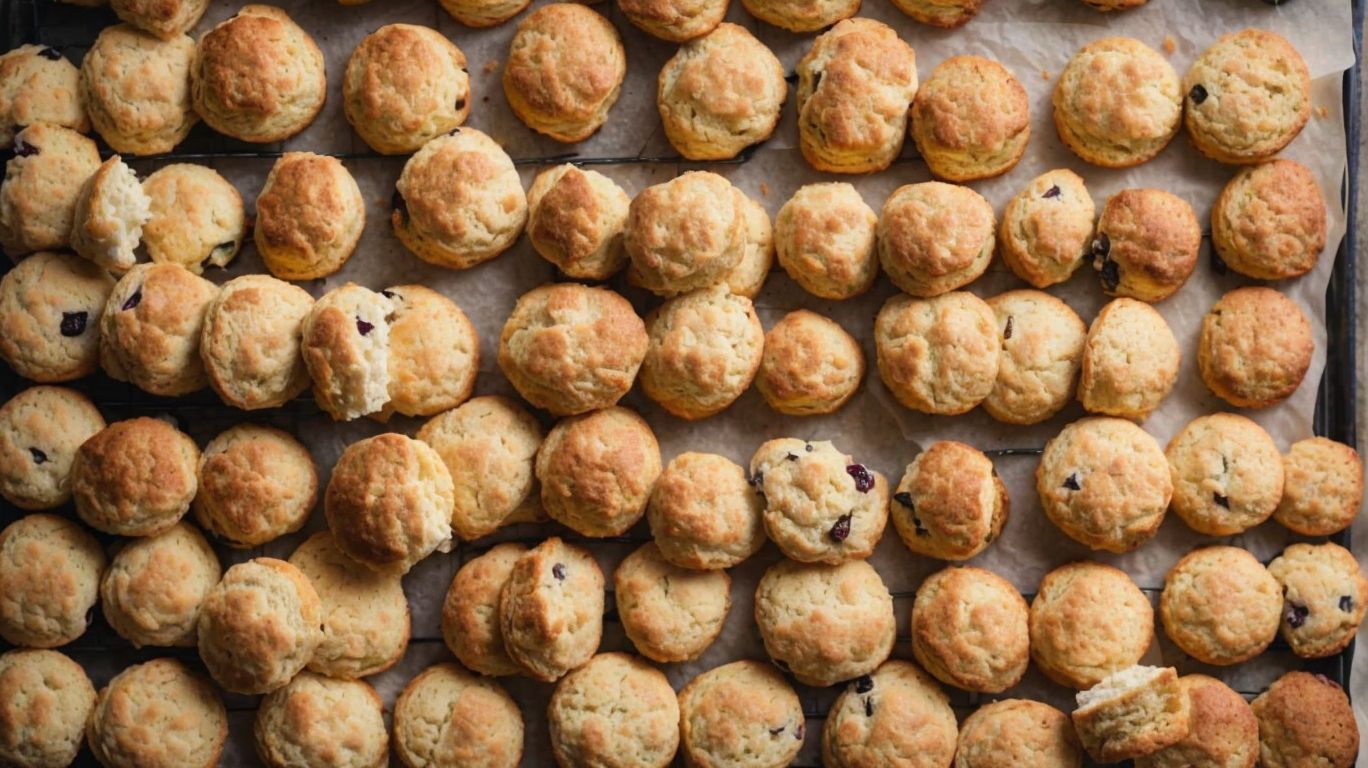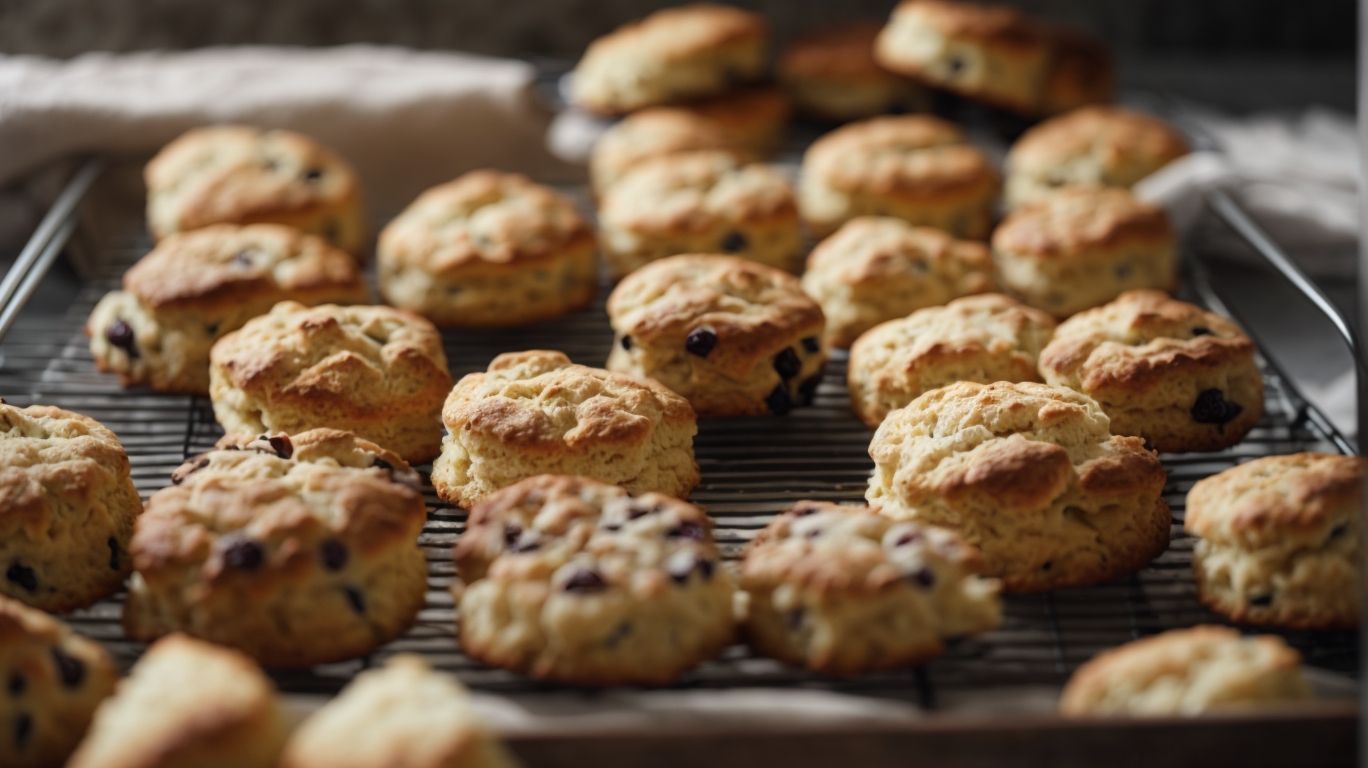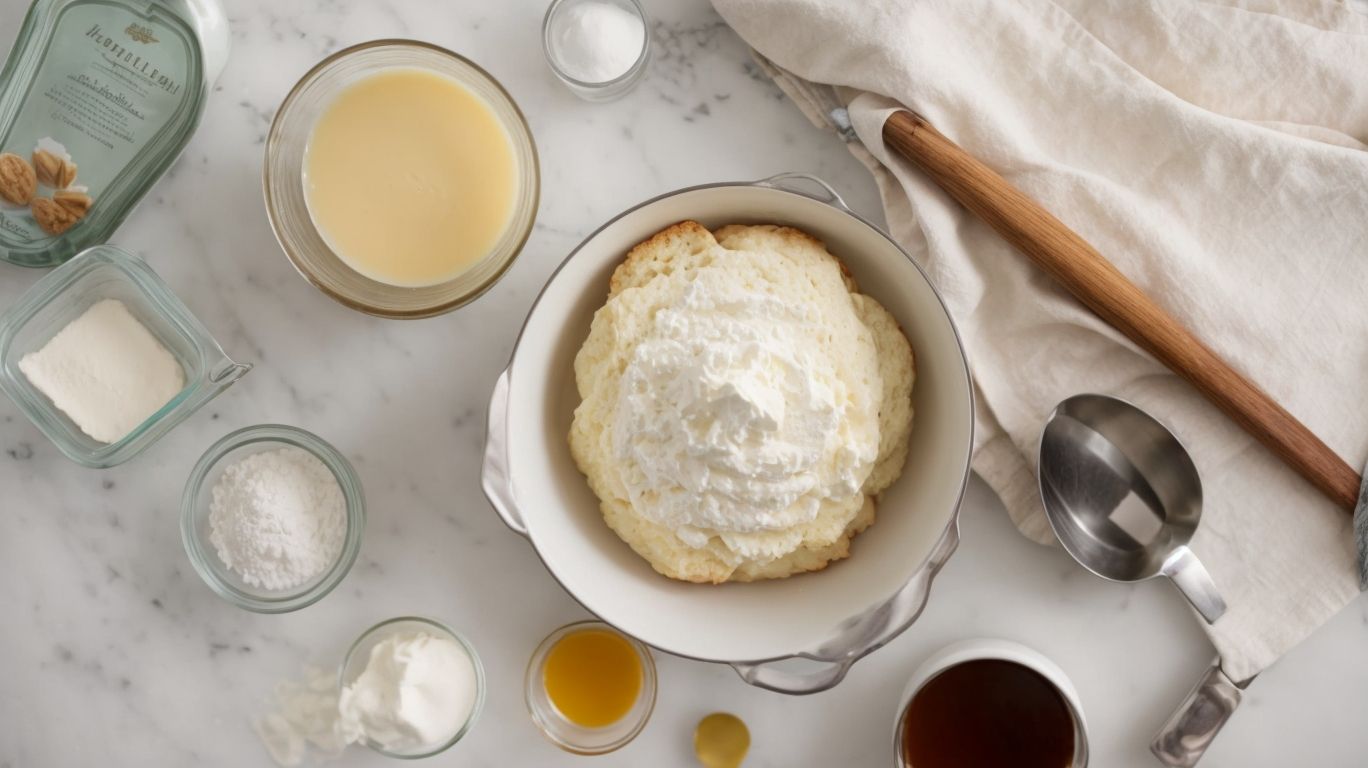How to Bake Scones Without Butter?
Craving a delicious scone but looking to cut out the butter? Look no further!
We explore everything you need to know about baking scones without butter. From the origins of this beloved treat to the various types and variations, we’ve got you covered.
Discover the benefits of omitting butter from your scone recipe, learn about alternative substitutes, and follow our step-by-step instructions for perfectly baked scones. Stick around for tips on storing and reheating your scones, as well as other mouth-watering variations to try.
Get ready to elevate your baking game with scones sans butter!
Key Takeaways:
What Are Scones?
Scones are a type of baked pastry that is popular in various cultures, known for their versatile nature and delicious taste.
Originating in Scotland, scones have a rich history dating back centuries. Their texture can vary from soft and flaky to dense and crumbly, depending on the ingredients and preparation method. Cream scones, a variation made with heavy cream or clotted cream, are particularly indulgent and decadent.
Scones come in a variety of flavors, from classic plain or fruit-filled options to more creative combinations like chocolate chip, pumpkin spice, or even savory versions with cheese and herbs. Whether enjoyed at breakfast with a cup of tea or as a teatime treat, scones are a beloved pastry that continues to delight taste buds around the world.
Origin of Scones
The origin of scones can be traced back to traditional British recipes, where they were originally created as a simple, unleavened bread cooked on a griddle.
Over time, scones evolved into the beloved pastry we know today, with the addition of ingredients like butter and baking powder. The Brits began enjoying scones during their afternoon tea rituals, often served with clotted cream and jam, a combination that has become iconic in British cuisine. This classic pairing spurred the popularity of scones, leading to various regional variations using ingredients such as fruit, nuts, and spices. From the highlands of Scotland to the bustling streets of London, these delectable treats have left a lasting legacy on both traditional and modern baking practices.
Types of Scones
Scones come in a variety of types and flavors, including traditional versions, modern adaptations, and creative twists that cater to diverse palates.
Classic scones are typically made with plain flour, sugar, butter, and milk, resulting in a slightly sweet, crumbly texture. These scones are often served with clotted cream and jam, following the traditional British afternoon tea tradition.
On the other hand, you can find savory scones that incorporate ingredients like cheese, herbs, and even bacon, perfect for those who prefer a more robust flavor. For those with a sweet tooth, there are fruit scones packed with raisins, currants, or dried fruit, adding a delightful burst of sweetness in every bite.
Why Bake Scones Without Butter?

Credits: Poormet.Com – Charles Flores
Baking scones without butter can offer a healthier alternative while maintaining the desired texture and flavor profile.
For health-conscious bakers, opting for a butter substitute in scone recipes can greatly reduce saturated fat intake and cholesterol levels. By using alternatives like Greek yogurt, coconut oil, or mashed bananas, you can still achieve that moist, tender crumb in your scones while enhancing their nutritional value. These substitutions add a unique twist to the traditional scone recipe, introducing new and exciting flavors that can elevate your baking experience. Embracing butter substitutes not only supports a healthier lifestyle but also opens new avenues for creativity in the kitchen.
Benefits of Baking Scones Without Butter
The benefits of baking scones without butter include lower saturated fat content, potential dietary accommodations, and a different taste profile that can appeal to various preferences.
By eliminating butter from scone recipes, you can significantly reduce the saturated fat content, making them a healthier alternative for those conscious of their fat intake. This makes them a great option for individuals looking to follow a heart-healthy diet without compromising on taste.
Baking scones without butter opens up a world of dietary flexibility, catering to lactose intolerant individuals or those following a vegan lifestyle. This adaptability allows more people to enjoy these delightful treats without any dietary restrictions getting in the way.
The absence of butter can create a scone texture that is lighter and flakier, with a unique flavor profile that can be just as indulgent and delicious as traditional butter-filled scones.
Substitutes for Butter in Scone Recipes
Several substitutes can replace butter in scone recipes, such as coconut oil, applesauce, or yogurt, offering alternatives that suit different dietary preferences and baking needs.
Coconut oil is a popular choice due to its light tropical flavor and solid texture at room temperature, mimicking the consistency of butter in baked goods. It works best in scones that require a flaky texture, and the oil should be solidified before incorporating into the dough.
On the other hand, applesauce adds moisture and sweetness to scones, making them softer and slightly denser; it is ideal for those looking to reduce fat content and add a fruity undertone to the scones.
Similarly, yogurt can enhance the tanginess and tenderness of scones by replacing some or all of the butter, resulting in a moist and flavorful end product. Both plain and flavored yogurts can be used depending on the desired taste profile of the scones.
How To Bake Scones Without Butter

Credits: Poormet.Com – Zachary Torres
Baking scones without butter involves following a modified recipe that uses suitable substitutes and adjusting the preparation method to achieve the desired texture and taste.
One key ingredient to replace butter in scones is coconut oil, which adds a lovely flavor and helps maintain moisture. Begin by preheating your oven to 400°F (200°C) and lining a baking sheet with parchment paper.
Baking instruction: In a large bowl, sift together 2 cups of all-purpose flour, 1/3 cup of sugar, 1 tablespoon of baking powder, and a pinch of salt. Cut in 1/4 cup of solid coconut oil until the mixture resembles coarse crumbs.
Next, create a well in the center and pour in 2/3 cup of almond milk. Gently mix until just combined; avoid overmixing to keep the scones tender.
Ingredients Needed
To bake scones without butter, you will need ingredients like flour, sugar, baking powder, salt, and suitable substitutes for butter, ensuring a light and fluffy texture in the scone dough.
In creating butter-free scones, it’s crucial to understand the significance of each ingredient. Flour forms the base of the dough, providing structure, while sugar adds sweetness. Baking powder serves as the leavening agent, helping the scones rise, and salt enhances the flavors. When substituting butter, options like coconut oil, Greek yogurt, or applesauce can be used to maintain moisture and richness. Finding the right balance ensures that the scones remain tender and delicious.
Step-by-Step Instructions
Follow these step-by-step instructions to bake scones without butter, including mixing the ingredients, shaping the dough, and baking at the recommended oven temperature for optimal results.
To begin, preheat your oven to 375°F to ensure it reaches the ideal temperature for baking scones. Assemble all your ingredients: all-purpose flour, baking powder, sugar, salt, milk, and oil. In a large mixing bowl, combine the dry ingredients – flour, baking powder, sugar, and salt. Make a well in the center and pour in the milk and oil. Gently mix the ingredients until a sticky dough forms. Next, transfer the dough onto a floured surface and shape it into a circle about 1-inch thick.
Tips for Perfectly Baked Scones Without Butter
To ensure your butter-free scones turn out perfectly, consider tips such as using a food processor for dough mixing, freezing scones before baking, and sprinkling sparkling sugar for added texture.
In terms of the dough, the food processor can quickly blend the ingredients without overmixing, resulting in a light and fluffy texture. Baking tips like preheating the oven and using a parchment-lined baking sheet can help achieve a golden-brown crust. Freezing the scones before baking not only enhances the flavors but also helps maintain the scone’s shape while they are in the oven.
How To Store and Reheat Scones Without Butter

Credits: Poormet.Com – Daniel Harris
Properly store butter-free scones in an airtight container or wrapped in parchment paper to maintain freshness, and reheat them in the microwave or oven for a warm and delightful tea-time treat.
When storing butterless scones, it’s crucial to keep them away from direct sunlight or heat sources to prevent them from becoming soggy or stale. Scone storage is best achieved in a cool, dry place, such as a pantry or cupboard. Avoid refrigerating them, as the moisture in the fridge can affect their texture. For long-term storage, consider freezing the scones in a freezer-safe bag or container.
Other Variations of Scones Without Butter
Explore different avenues of scone variations without butter, including savory options, vegan recipes, and gluten-free alternatives that cater to diverse tastes and dietary preferences.
In terms of savory scone recipes without butter, you can experiment with ingredients like cheese, herbs, and spices to create a delightful twist on the traditional sweet scone. For those following a plant-based diet, vegan scones offer a delicious alternative using plant-based fats and dairy substitutes. For individuals with gluten sensitivities or allergies, gluten-free scones without butter provide a tasty solution using alternative flours such as almond flour or oat flour.
Savoury Scones Without Butter
Savoury scones without butter offer delightful options for tea time, featuring ingredients like chopped nuts, herbs, and spices that create a savory twist on the traditional sweet scone.
These scones are not only easy to prepare but also allow for versatile flavor combinations, making them a perfect choice for any tea gathering. Consider adding ingredients such as sun-dried tomatoes, feta cheese, or caramelized onions to elevate the savoriness of the scones. The absence of butter results in a lighter texture, ideal for pairing with a steaming cup of your favorite tea. Experiment with different seasoning choices like garlic powder, smoked paprika, or fresh dill to customize the scones to suit your taste preferences.
Vegan Scones Without Butter
Vegan scones without butter offer a dairy-free alternative that can be made using ingredients like plant-based milk, dairy-free butter substitutes, and a pastry scraper for easy dough handling.
For those looking to enjoy delectable scones while following a plant-based diet, vegan scones are a perfect choice. These scrumptious treats are not only free of animal products but are also simple to make with a few basic ingredients.
To create the perfect vegan scone, you will need items like non-dairy milk, such as almond or oat milk, and a plant-based butter substitute. A pastry scraper can be a handy tool for ensuring your scone dough is perfectly mixed and shaped. This versatile tool helps bakers effortlessly handle the dough, resulting in beautifully textured scones.
So, next time you crave a dairy-free snack, try whipping up a batch of mouthwatering vegan scones!
Gluten-Free Scones Without Butter
Gluten-free scones without butter cater to individuals with dietary restrictions, offering tips for freezing dough, using alternative flours, and creating delicious scones that are gluten-free and butter-free.
In terms of freezing tips for gluten-free scone dough, ensure you shape the dough into scone forms before freezing for easy baking later. Using almond flour or coconut flour instead of traditional wheat flour can result in a wonderful texture and flavor in your scones. Incorporating ingredients like coconut oil or applesauce in place of butter can yield moist and tender scones. Experimenting with different fruit or nut additions gives these scones a delightful twist, enhancing their taste and nutritional value.
Frequently Asked Questions
What ingredients can I use to replace butter in my scone recipe?
Some great alternatives to butter in scone recipes include coconut oil, vegetable shortening, or even mashed avocado.
Will using a non-dairy milk affect the texture of my scones?
Yes, using a non-dairy milk may result in a slightly different texture than using traditional milk. However, the difference is usually minimal and the scones will still be delicious.
Can I use oil instead of butter in my scone recipe?
While oil can be used in place of butter, it may result in a denser texture. If using oil, make sure to use a neutral flavored oil such as canola or vegetable oil.
Is it possible to make vegan scones without butter?
Absolutely! There are many vegan scone recipes available that do not use butter at all. Coconut oil, vegan margarine, or nut butter are all great substitutes for butter in vegan scones.
What can I add to my scone dough to make it more flavorful without using butter?
To add flavor to your scones without using butter, try adding ingredients like dried fruit, nuts, or spices. You can also brush the tops of your scones with a mixture of honey and water for a flavorful glaze.
Can I use applesauce instead of butter in my scone recipe?
Yes, applesauce can be used in place of butter in scone recipes. However, it may result in a slightly different texture. It is best to use unsweetened applesauce to avoid making the scones too sweet.

